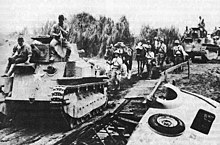2nd Tank Division (Imperial Japanese Army)
 From Wikipedia - Reading time: 5 min
From Wikipedia - Reading time: 5 min
| 2nd Tank Division | |
|---|---|
 Japanese tanks moving toward Manila | |
| Active | 1942–1945 |
| Country | |
| Branch | Imperial Japanese Army |
| Type | Armored division |
| Garrison/HQ | Tokyo, Japan |
| Nickname(s) | 撃 = Geki (Attack) |
| Engagements | |
The 2nd Tank Division (戦車第2師団, Sensha Dai-ni Shidan) was one of four armored divisions of the Imperial Japanese Army in World War II.
History
[edit]The 2nd Tank Division was raised in Manchukuo on June 24, 1942.[1] Stationed in Mudanjiang in northeastern Manchukuo, it was tasked primarily with border patrol of Manchukuo's eastern frontier with the Soviet Union under the overall command of the Japanese First Area Army.
In February 1944, the 11th Tank Regiment was sent to the Kuriles. In the following month, the Recon Unit was renamed the 27th Tank Regiment and with the AA unit, sent to China.[1] As the situation in the Pacific War against the Allies deteriorated for Japan, in early August 1944 the remaining units of the 2nd Tank Division were reassigned to the Japanese Fourteenth Area Army, and sent to the Philippines, where it was deployed on the main island of Luzon.[3]
In January 1945, the US forces made amphibious landings on Luzon and the army units pushed inland. General Tomoyuki Yamashita held back the tank division so as not to waste them in large scale counterattacks against superior forces.[4] He had them withdraw inland to northern defensive positions. During this time, the 2nd Tank Division came under heavy air attacks. Most of the 2nd Tank Division, dug in around San Jose. It lost 108 of its 220 tanks in heavy fighting in just over a week.[5] By March 5, the division had lost a total of 203 Type 97 Chi-Ha and 19 Type 95 Ha-Go tanks, and two of its new Type 4 Ho-Ro self-propelled guns.[6] The remaining tanks were used to support infantry or were dug in like pillboxes and annihilated during the remainder of the Battle of the Philippines[5] in various engagements on Luzon, Leyte and Mindanao.
The 2nd Tank Division was reconstituted in Japan as a training unit after the disaster in the Philippines. In February 1945, its 11th Armored Regiment was transferred to the control of the Japanese Fifth Area Army and attached to the 91st Infantry Division. It was stationed in the northern Kuril Islands, where it was in combat against the Soviet Red Army at Paramushir during Invasion of the Kuril Islands at the end of World War II. It was officially demobilized in September 1945 with the rest of the Imperial Japanese Army. Also, the reconnaissance regiment was transferred to Okinawa where it was converted to the 27th armored regiment attached to the 24th Division, and finally anti-aircraft company was transferred to 20th Army.
Commanding officer
[edit]| Name | From | To | |
|---|---|---|---|
| 1 | Lieutenant General Tasuku Okada | 20 September 1942 | 7 December 1943 |
| 2 | Lieutenant General Yoshiharu Iwanaka | 27 December 1943 | 30 September 1945[7] |
See also
[edit]Notes
[edit]- ^ a b c d e f g h Rottman & Takizawa 2008, p. 12.
- ^ a b c d e f g h i j k l Rottman & Takizawa 2008, p. 56.
- ^ Rottman & Takizawa 2008, pp. 12, 54.
- ^ Zaloga 2007, pp. 38, 39.
- ^ a b Rottman & Takizawa 2008, pp. 12, 54, 55.
- ^ Zaloga 2007, p. 39.
- ^ Rottman & Takizawa 2008, pp. 55, 56.
References
[edit]- Breuer, William B. (1986). Retaking The Philippines: America's Return to Corregidor & Bataan, 1944-1945. St Martin's Press. ASIN B000IN7D3Q.
- Frank, Richard B (1999). Downfall: The End of the Imperial Japanese Empire. New York: Random House. ISBN 0-679-41424-X.
- Jowett, Bernard (1999). The Japanese Army 1931-45 (Volume 2, 1942-45). Osprey Publishing. ISBN 1-84176-354-3.
- Madej, Victor (1981). Japanese Armed Forces Order of Battle, 1937-1945. Game Publishing Company. ASIN: B000L4CYWW.
- Morison, Samuel Eliot (2001). The Liberation of the Philippines: Luzon, Mindanao, the Visayas 1944-1945 (Reissue). History of United States Naval Operations in World War II. Vol. 13. Castle Books. ISBN 0-7858-1314-4.
- Rottman, Gordon L.; Takizawa, Akira (2008). World War II Japanese Tank Tactics. Osprey Publishing. ISBN 978-1846032349.
- Smith, Robert Ross (2005). Triumph in the Philippines: The War in the Pacific. University Press of the Pacific. ISBN 1-4102-2495-3.
- Zaloga, Steven J. (2007). Japanese Tanks 1939–45. Osprey Publishing. ISBN 978-1-8460-3091-8.
 KSF
KSF